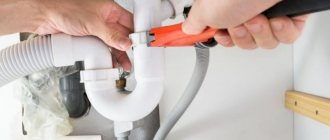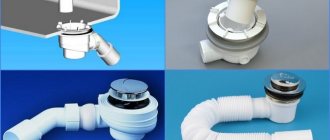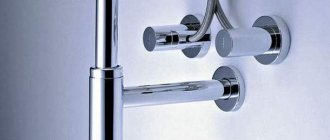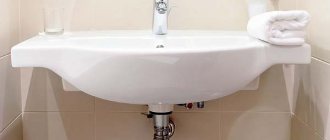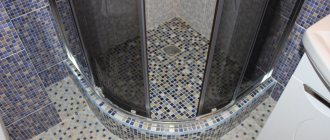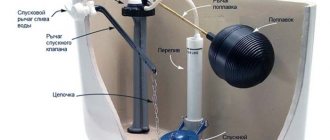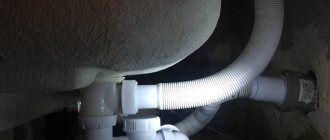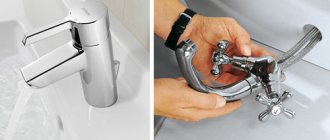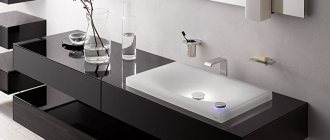Having decided to replace the plumbing in the house or install a new one, everyone begins to study bathtubs, washbasins, faucets and no one remembers the detail on which the high-quality operation of all this equipment depends. Siphons are a mandatory element of most plumbing fixtures. Apartment residents should be grateful to them for the fact that the unpleasant smell of sewage water coming from the sewer pipes does not enter the premises. In addition, the water plug located inside these devices is a barrier that isolates the sewer pipes from blockages. However, when choosing a siphon for a bathroom sink, you need to take into account not only its technical characteristics, but also its appearance.
How to choose the right product?
in the drainage system, each device is connected independently. Therefore, when choosing a drainage system, it is important to consider which plumbing unit it will be connected to.
As mentioned above, each device has its own siphon; you will have to connect the drain to a sewer of a certain size, so you need to know the diameter of the hole. In addition, there are differences between domestic and foreign plumbing fixtures. When purchasing, it is better to immediately clarify this information with the seller; free space plays an important role in choosing a design. If there is not enough space, you can use a corrugation that bends at any angle. And if there are empty squares under the sink, it is better to install an elbow or a flask; The connection between the drain and the pipe must be made of plastic. This material is not subject to corrosion, is easy to install and lasts a long time.
What is a siphon for?
The design of all drain pipes leading from a shower, bath or kitchen sink is based on one principle. Used water will never immediately flow into the sewer system, because a water seal serves as an obstacle to this. It would seem that it would be easier to connect the sink or bathtub directly to the sewer pipe, and that’s it. But it's not that simple.
With such a direct connection, large particles of debris will invariably clog the system, and the kitchen or bathroom will immediately be filled with unpleasant sewer “odors” according to the laws of physics. To prevent this from happening, siphon structures are installed.
Therefore, the question about the purpose of the siphon will have a simple logical answer: “For sanitary protection from debris, odors and microbes present in sewer fumes.” It is much easier to remove and clean the siphon itself than to change sewer pipes or constantly fight for clean indoor air.
Traditionally, it is an elbow or a piece of pipe, geometrically curved, made of various materials. It is mounted immediately under the sink in the common section of pipe leading to the sewer hole. Thanks to this design, it is always filled with water, which serves as a barrier to harmful and unpleasant odors.
Assembling siphons under the sink for the kitchen Ani plast and Ani grotto
Siphons of domestic production of the Ani Plast and Ani Grot brands belong to the class of inexpensive but high-quality plumbing products. Thanks to their attractive appearance, excellent performance characteristics, high quality manufacturing and low cost, they are widely used in the Russian market.
Video - Sequence of actions when assembling a siphon of the “Ani Grot” brand
Domestic manufacturers of drainage fittings offer consumers various models of siphons. Their assembly and installation is carried out according to the general principle:
- When purchasing, the product contents are checked;
- According to the diagram attached to the instructions, the device is assembled;
- installation begins by connecting the siphon inlet pipe to the sink;
- then the main block is assembled;
- the drain pipe is connected to the sewer system;
- At the final stage, the tightness of the connections is checked.
Video - Assembling a siphon for the Ani Plast sink
In conclusion, we note that a properly assembled siphon will work flawlessly for a long time. The service life of a plumbing fixture increases if the operating rules are followed, regular cleaning of contaminants and timely replacement of worn gaskets.
We recommend that you pay attention to the article - How to embed a sink into a countertop, which describes in detail how to install a sink with your own hands
Prices for kitchen sinks
Kitchen sink
Assembling the siphon is not particularly difficult; if you carefully and carefully carry out the manipulations recommended in the instructions, even an inexperienced person in plumbing can handle the job. Nevertheless, if you are completely unsure of your abilities, it is better to turn to specialists, since installing any plumbing fixture is a very responsible undertaking.
Sink drain - assembly and installation of drain with overflow
Published by Artyom on 03/04/2019 03/04/2019
The final stage of assembling the drainage system is the installation of a siphon. When doing this work, you need to equip yourself with certain tools and knowledge.
Information about the structure of various types of drains and the features of their installation will be useful when preparing for work. Installing a drainage system in the kitchen is a simple job that even a non-professional in plumbing can handle.
Siphon installation rules
In order for the purchased siphon to function correctly, it must be assembled in accordance with the requirements specified in the instructions.
The sequence of assembly of the structure is as follows:
- A large flat gasket should be placed on the large hole in the main tube and the existing cap should be screwed to the side.
- It is necessary to screw a union-type nut onto the pipe, and a cone gasket on top of it. Then the assembled structure must be inserted into the upper hole and screwed tightly without squeezing it.
- If a siphon with an overflow is being assembled, this part must be connected to the outlet of the pipe. To do this, you first need to put a nut on the outlet, and a ring gasket on top of it. Next, the assembled structure must be connected to the overflow, placing it with the blunt end towards it and tightening it with a nut. If the siphon design does not provide for an overflow, this assembly step must be skipped.
- At the final stage of assembly, you should take the corrugated pipe and carefully put a union nut on it, and a cone-type gasket on top of it. After this, the pipe must be screwed to the siphon, thereby completing the assembly process.
In order to install the assembled siphon directly into the sink, you must follow the following recommendations:
- First of all, you should put the o-ring on the pipe, placing it with the strips facing up. The second ring included in the kit should be pulled over a metal mesh, which should then be placed above the sink.
- Next, you need to adjust the siphon to the drain hole in the sink.
- The screw should be screwed into the grille.
- Using the rigid tube that comes with the siphon, you need to connect the assembled structure to the sewer. It should be noted that at this stage the process occurs much faster in relation to the corrugated pipe.
- At the final stage, you need to run water through the siphon, checking the tightness and correctness of its installation.
Methods for eliminating leaks
As a rule, repairing a siphon is not a difficult task. And the materials necessary for this can be found in the pantry of almost any home. Below are some recommendations on what to do if the siphon is leaking.
Required Tools
Plastic siphons can be disassembled by hand, so no special tools are needed. Although in some cases a screwdriver, a cable for cleaning drain pipes may still be useful (a metal brush with a long handle or even an ordinary wire brush will also work), and it is advisable to stock up on a rag and a container for water. To restore the tightness of spare parts and their joints, silicone glue or sealant, a “liquid nails” type composition, and sometimes even a regular medical bandage are useful.
Siphon leaks can be eliminated using “liquid nails”
If you have to disassemble a metal siphon, especially one that has been in use for a long time, you may need tools such as a grinder and a drill. With their power, it will be possible to disassemble the siphon by sawing off the caps of the bolts, and then drilling out what is left. In order not to damage the metal siphon during disassembly, it is recommended to use power tools.
Restoring the tightness of gaskets
Abrasion or other changes in the condition of the gaskets can cause the siphon to begin to leak. Rubber parts that have hardened during use are best replaced. Usually they are available in any specialty store. In order for the purchased parts to last longer, they are lubricated with liquid soap or Vaseline, which facilitates the installation process.
However, there is not always the desire or opportunity to purchase new gaskets. In this case, you can try to restore the old ones. To restore them, they must be lubricated with silicone glue, sealant, or a compound called liquid nails, and then put in place. When the applied composition dries, the plumbing fixtures can be used. This measure will extend the life of the rubber gaskets for several more years.
Repairing cracks
If the pipe is cracked at the seam, then repairing it is quite simple. To begin with, the split site is cleaned with sandpaper and then lubricated with pre-diluted epoxy glue. If desired, dyes can be added to the composition used.
To repair cracks you will need epoxy glue
When the surface is lubricated, it is wrapped with a medical bandage. This event is performed two or three times. This creates several layers of epoxy glue and bandages on the pipe. The drying time for this design is about six hours. After drying, the siphon can be put back in place and the plumbing can be used. A pipe reinforced in this way becomes much stronger than the one originally purchased.
Sealing connections
Sealing of connections may be necessary due to manufacturing defects or during operation. Sometimes it becomes necessary to additionally seal the joints of the siphon parts. For example, a worn thread prevents the rubber gasket from being pressed tightly against the hole. In this case, tow or silicone tape is used for compaction. It is important to remove excess sealant after securing the nut. In some cases, if the thread is seriously damaged, cold welding can be used, however, this will extend the service life for only a short time, since the fragile plastic will soon continue to crumble. In this case, it is better to take care of purchasing a new siphon.
How to care for the siphon?
Any type of sink drain requires regular maintenance. It consists of inspecting for damage, thoroughly cleaning the product and thoroughly removing any blockages that have formed.
Careful operation of the sink, the use of special protective grilles or food choppers increase the interval between cleanings, but sooner or later such a need arises
The complexity of the procedure is determined by the material and design. Corrugated siphons are cleaned only after complete disassembly, while in bottle siphons it is enough to unscrew and rinse the flask.
Some devices are easily pierced with a special tube. For cleaning purposes, chemicals such as “Ruff” and “Phlox” are used.
They should be used with caution, especially for plastic models
To prevent the siphon from becoming so clogged, you can periodically flush it with hot water with the addition of a handful of citric acid.
It is also worth paying attention to the fact that rubber seals wear out quickly. It is better to try to replace them approximately every six months
Common types
Manufacturers produce several types of sink siphons. They are selected depending on the characteristics of the installation site.
Some types of siphons: bottle with a tube, bottle with partitions, tubular
Corrugated drain
The corrugated tube is convenient to use when the sink drain hole has a non-standard location. This device is also used if you plan to install additional equipment or any necessary items under the sink. When connecting it to the sink, you need to pay attention to the amount of water in the curved place. It should be enough to create a reliable water lock, which guarantees reliable protection against the penetration of odors from the sewer.
A drain in the form of a corrugated tube is not an ideal design, because dirt quickly accumulates on the ribs of the product.
Structurally, the corrugated siphon consists of the following elements:
- pipe with grille and union nut;
- corrugated tube
Additionally, pipe fastening may be required.
Drain with corrugated pipe
The corrugated drain is installed in a matter of minutes. First, we attach the outlet pipe with the grate to the sink. Fixation is carried out using the gasket and screw included in the kit. Then the corrugation is inserted into the pipe at one end and secured with a nut, and the other side is inserted into the sewer pipe. If cleaning is necessary, the corrugated hose is disconnected from the pipe and the sewer. Then it is washed or replaced with a new one.
Bottle drain
Bottle siphons are most often installed. They are well suited when you need to drain dirty water and other waste from multiple sinks. In this case, the required number of special bends is installed.
The design of the bottle drain consists of the following elements:
- metal or plastic grille;
- intake pipe;
- bottle container;
- pipe for draining sewage into the sewer;
- a transition piece that allows you to connect the siphon to the sewer system.
The bottle drain is a completely rigid product. If necessary, the design is supplemented with corrugation for more convenient connection to the sewer. Cleaning the bottle drain is done by unscrewing the bottom part of the bottle-shaped container and removing accumulated dirt.
Pipe drain
This type of siphon is installed not only on sinks, but also on bathrooms. It has a completely rigid structure - outwardly similar to the letters S and U.
Simple pipe (straight-through) siphon
Since many modern kitchens have dishwashers, the pipe siphon may have an additional outlet.
Pipe siphon for sink McAlpine (UK) with outlet for household appliances, 40 mm (MRSK6). The MRSK4A model is equipped with an angular outlet. When choosing, be guided by the specified sizes
There are models of tubular siphons with a break in the stream flow. Such siphons are not attached to the sink - after installation there is a difference between the siphon and the sink. It is necessary to prevent germs from the sewer from entering the sink. They are used in preschool institutions and catering establishments.
Flat drain
This is a small siphon under the sink, where size is critical. It is usually used when a “washing machine” or dishwasher is installed under the sink. There are models with a break in the jet flow.
The design is a regular knee, but it saves space
In addition to small dimensions, a distinctive feature of a flat drain is also its rigid design. Such siphons rarely become clogged. If there is a need to perform a complete cleaning, the grille is unscrewed, and then the entire structure is removed from the sink.
With overflow
When the sink has overflow protection, a siphon with overflow is installed under it. The design of the product includes an additional pipe, to which a small diameter tube is connected from the overflow hole in the upper part of the sink. This design prevents the sink from overflowing with water and reduces the risk of flooding the room and neighbors living on the floor below.
A siphon with overflow is installed not only for sinks, but also for sinks
There are also drains with one or two outlets at the neck. They are used when it is necessary to additionally connect a dishwasher or washing machine.
Please note how many components a pipe siphon with overflow has. If you are afraid of getting confused when installing it yourself, it is better to invite a professional plumber
Recommendations for choosing a siphon for a sink
When deciding on a siphon for a washbasin, you need to take into account the following points:
The type of sink structure under which the pipe will be placed. If there is enough free space, then it is better to prefer more reliable metal siphons. In addition, they have excellent external data. As for plastic models, they should be used exclusively in closed structures. Room area. The best option for small bathrooms is corrugated siphons. In addition to their compactness, products of this type have good flexibility. This makes it possible to install them in narrow niches next to the washing machine. Country houses with non-permanent residence are recommended to be equipped with the so-called. "dry" siphons. The absence of moisture inside such a structure makes it possible to painlessly tolerate a drop in air temperature to sub-zero values. Throughput characteristics
It is important to calculate that the pipe is able to pass through the entire volume of processed water. This is especially true for situations where household appliances are directly connected to it.
Manufacturers
The choice here is simply huge, from cheap Chinese goods to expensive branded ones. The choice for each situation is individual and is based on the installation location of the device, what kind of work it will perform and financial capabilities.
Some manufacturers:
- Akvater is a Russian company, quite well known and has its own sales market.
- AlcaPLAST - products of this company, a compromise of price and quality.
- Hansgrohe is a brand from Germany, a leader in quality and design.
How to fix it?
One of the reasons why you have to change the siphon is when water starts dripping from the bowl, the hose itself is leaking, or you hear something gurgling. In this case, it is necessary to check the tightness of the connections, which may be compromised due to the service life of the repair kit. In some cases, it is possible to dismantle the siphon with your own hands, in particular, if it is entirely plastic; if you have a siphon made of more expensive material such as brass or non-ferrous metal, you should seek specialized help.
To disassemble spare parts, you need to know a few things:
- in the sewer system the pressure corresponds to atmospheric pressure, due to which it will not be difficult to disassemble the siphon, especially if it is plastic;
- it is necessary to prepare a bucket and rags to collect liquid from the pipes, which will spill if all elements of the siphon are unscrewed;
- we stop the water supply and dismantle the siphon;
- all parts must be cleaned if they are still suitable for further work;
- depending on the cause, it is necessary to eliminate the problem, and this may be: changing the repair kit, removing blockages, cleaning parts, eliminating cracks in the pipe (using glue and cloth), sealing connections, etc.;
- if it is no longer possible to repair, it is worth buying a new siphon; when assembling at home, you need to be guided by the drawing that is attached to the siphon, and then connect it to the sewer according to the diagram.
Installing a siphon: select the material and assemble it yourself
Pressing the bulb several times is not difficult, but replacing the batteries in the siphon is an additional headache. And what happens if the electric motor still breaks down....
Battery-powered siphon with mechanical filter
The siphon is not used to clean the aquarium only if the aquarium is completely planted. Firstly, I can't imagine how you could siphon, for example, Himianthus cubes or Eleocharis.
This will inevitably lead to damage to the aquarium plants. Secondly, all sediment accumulated in the soil is food for aquarium plants. I haven't dumped the soil in years, the floors were completely dirty, but now I feel like there will be a root in my soil.
But still, if there are areas in the aquarium where plants do not grow siphonically, soil is necessary.
The soil exceeds the number of fish in the aquarium: from once a week to once a month. The soil siphon is suitable for combination with partial water changes - 20% of the sediment is dried, 20% of fresh water is added.
It is not difficult to make a siphon for cleaning an aquarium with your own hands. For this you need a hose and a plastic bottle.
We cut off the bottom of the bottle and connected the door to the tube. It is not easy to secure the pumping bulb, so the pipe must be removed to create a reverse draft. But, in my opinion, a siphon for an aquarium is not equipment that is worth saving less than 100 rubles. It's better to buy ready-made, cheap ones, and you'll be served for years.
When choosing a siphon, it is necessary to take into account the diameter of the pipe; the larger the diameter of the pipe, the greater the pressure of the water flow.
And if you have a tank with a volume of 20 liters, then you do not have time to cover the entire earth faster than combining all the water in the aquarium :). A 100-liter aquarium fits well into the diameter of the pipe in centimeters. The siphon process alone will collect about 20 percent of the water needed for a water change.
Popular manufacturers
The top ten popular manufacturers of siphons and plumbing devices include:
- Viega;
- Orio;
- AlcaPlast;
- M.C.Alpine;
- H.L.;
- Geberit;
- Blanco;
- Wirquin;
- Suntek
The first manufacturer on the list is from Germany, engaged in the production and sale of various engineering equipment. The assortment is extensive - about 17 thousand items. The products have been nominated and awarded more than once in the field of design and technology.
- Viega siphons are not only premium class, but also regular budget models that are of high quality. The second on the list is a domestic manufacturer that supplies budget product options to the market. The products are environmentally friendly and have a long service life. The product range is large and varied.
- AlcaPlast is a Czech brand known on the market since the 90s. The range of branded products is small, but the main criteria of the company are design and quality. The latest new products meet the criteria of technological effectiveness and are equipped with modern automation. MCAlpine produces a variety of plumbing fixtures in a wide range. The company is English and has an extensive dealer network around the world. The product is one of the most counterfeited among other competitors. Manufacturers even offer instructions to customers, according to which the original can be distinguished even by its packaging.
- Branded products from Hutterer & Lechner are presented on the market as innovative. It is believed that individual units of plumbing fixtures can be combined with various pieces of equipment, all parts are interchangeable. Installation of many models is convenient thanks to special hinge mechanisms.
- Geberit is a Swiss company specializing in the production of plumbing fixtures and sewerage systems. The devices are distinguished by increased attractiveness and reliability.
- Blanco is another German manufacturer on this list. The company supplies the market with various models from the most budget to the most expensive. The range of models is very diverse. At the same time, one type of siphons on the market can be made of different materials. The buyer is immediately given the opportunity to compare products.
- Wirquin is a French company that offers customers a variety of products. The company unites several production facilities located in different countries. The main criteria for products are reliability and quality.
- Suntek is a Russian manufacturer that offers inexpensive devices for plumbing fixtures of various types. The company manufactures its products from plastic, and all products come with a 10-year guarantee.
- Jimten is an Italian company known on the world market for many years. Italian plumbing has long been synonymous with quality, and Jimten only confirms the statement.
Installation nuances
To install a siphon on a sink, an experienced person needs to spend a few minutes. If you don’t succeed so quickly, it’s okay. First you need to prepare the tools and consumables. The maximum that may be needed:
- screwdriver;
- gas key;
- sealant.
As a rule, when installing plastic products, all you need is a flat-head screwdriver.
If it is necessary to change the siphon, the old product is first dismantled. This procedure begins with installing a basin or other container under the drain to prevent water from getting onto the floor. First, all parts of the plastic siphon are removed. Then the protective grille is removed by unscrewing the screw. If a metal drain is dismantled, you will have to use a gas wrench.
Finally, the inside of the drain hole in the sewer riser is cleaned of contaminants. You can use a rag or paper towel for this.
How to collect drain correctly
At the beginning of the process, you need to check that all parts are present. To do this, we study the attached instructions and lay out all the elements, for example, on a table.
A bottle drain is often installed. Its assembly is carried out in the following sequence:
- The individual parts of the flask are connected after installing a gasket of small thickness. The sealing element must be pressed well against the part from all sides.
- The nut is secured to the corrugation.
- A cone-shaped gasket is placed on the corrugated pipe. The sharp part of the sealing element is located closer to the edge.
- The corrugated tube is inserted into the outlet pipe of the flask and secured by tightening the nut.
- On the other part with the grille, a second nut and gasket are fixed.
- The two separate parts of the siphon are connected by tightening the nut.
At the end of the process, the drain is secured under the sink. If necessary, you can use silicone sealant to improve the tightness of all siphon joints. It is recommended not to use too much force when tightening the nuts.
The nuts are tightened by hand! Don't use keys!
Installing a new device
The assembled drain structure is fixed to the sink as follows:
- gaskets in the form of rings are placed under the grate and on the top of the siphon;
- the assembled drain element is pressed from below to the hole in the sink, and a grate is installed on top from the side of the bowl;
- the screw is tightened;
- a nut and an o-ring are put on the pipe;
- the siphon is inserted and the nut is tightened;
- a hose is screwed to the siphon;
- the second end of the hose is connected to the sewer.
If necessary, an adapter is additionally used if the parts at the junction have different diameters. At the end of the installation process, the functionality of the drain is checked by filling it with water and checking for leaks.
What materials are the devices made from?
In the production of siphons, different types of raw materials are used. Each of them has its own advantages and disadvantages
When choosing a suitable device, it is important to make sure that the material from which it is made is quite durable, resistant to corrosion and oxidation. Its service life depends on these characteristics
Available plastic products
Plastic siphons are the cheapest and most common devices with a simple design and a small number of connections.
Devices are made from PVC, polyethylene, polypropylene. The latter option is preferable, as it lasts longer, has better strength and is less sensitive to high temperatures.
The range of PVC products includes improved branched models designed for two-section sinks and side-by-side sinks
Thanks to the smooth and even inner surface, impurities contained in the water are not deposited on the walls. Some manufacturers apply antibacterial coatings to the cavity to prevent strong sedimentation of dirt and grease.
Plastic products are very flexible. Most of them are equipped with bendable corrugated bends, which quickly take the shape required for installation.
Durable metal devices
In the manufacture of metal products, brass, bronze, copper, and chrome plating are used. They stand out for their stylish design, which perfectly complements luxury interiors.
High-tech bronze products look impressive and stylish, but they are not entirely practical for the kitchen. They are often chosen for bathrooms
It should be taken into account that metal pipes require precise sizing during installation, they are difficult to shorten, and maintaining the original appearance takes a lot of time and effort.
Such devices are more appropriate in bathrooms, where they will be visible, performing a decorative function.
Sink drain hole size
Add to bookmarksPrint version
When we open the tap in the kitchen or bathroom, we know that water, entering the sink, flows out of it into the drain hole. However, it does not immediately enter the sewer pipe, but passes along this path through a special drainage device called a siphon (hydraulic seal) and operating using the principle of communicating vessels. The article contains information about siphons for washbasins, but much is also suitable for sealing devices for sinks and bathtubs.
Purpose
A water seal is an intermediary device between the sink and the sewer pipe, the main task of which is to ensure the timely removal of liquid into the sewer drain. Secondary (but no less important) functions are preventing pipes from clogging by trapping debris and protecting against the entry of odors from the depths of the sewer into the room.
Types and design features of valves
At the moment, there are three main design types: pipe, corrugated and bottle, as well as their varieties for solving certain problems. For example, a flat siphon was created to save space under a sink or bathtub, and hidden/box siphons appeared to drain water used in washing machines. Dry seals are designed to solve problems in periodically occupied homes. Structural elements have also been added to protect the bathtub, washbasin, and sink from overflowing.
Pipe siphon
There are two modifications of pipe devices: conventional and flat, used in cases of vertical space limitations. It is most often used for washbasins in bathrooms, where it is usually visible. It has an attractive design, is usually made of metal (usually chrome-plated brass), and is quite compact.
A hydraulic lock is formed in a bent pipe bend. This knee is usually removable. For emergencies, it often has a drain hole. Parts of this structure are usually fixed, but sometimes they can have some mobility.
Advantages:
- simple design,
- affordable price due to ease of manufacture,
- slightly susceptible to blockages, having a sufficient flow area,
- easy to install and maintain.
Flaws:
- shallow water seal,
- the need for careful selection locally due to the rigidity of the structure.
Corrugated siphon
The device is made of a flexible plastic tube with corrugated pleats. The inlet pipe has a connecting unit at the sink drain - an inlet compactor that seamlessly turns into a corrugation.
Due to the flexibility provided by the corrugation, it has the following advantages:
- The design has a minimum of joints, therefore it is less susceptible to leaks,
- plasticity makes it possible to create any shape, so it can be placed in a narrowed space and conveniently “reach” the drain.
There are also disadvantages: it is impossible to connect an overflow hose and a hose that drains waste water from the washing machine to such a valve. Another disadvantage is the presence of folds in which a lot of dirt and grease settles and collects. To clean a corrugated pipe, you must either use chemicals or dismantle the entire pipe.
Bottle siphon
Devices of this type received this name because of the shape of their central part - the flask, in which a hydraulic seal is formed, small debris settles and accumulates.
The design of the device consists of several separate parts, mounted on site and allowing the possibility of connecting a drain hose for a washbasin with an overflow, or a hose from a washing machine. It is connected to the sewer with a flexible or rigid pipe. The advantages include: easy assembly and disassembly, ease of maintenance. An accidentally lost small item will not fly down the drain along with the flow of water, and can be found at the bottom of the tank. The downside, compared to a corrugated shutter, is more complex installation.
Siphon flat
A special type is the drain device, which has a flat design. It is used when other types of devices are not suitable for installation due to their dimensions.
Hidden shutter
Made in the form of a channel system cast into the body of a plumbing fixture, including overflows. Found in modern washbasins. Thus, the designers minimized the number of butt joints, which are sites of potential leaks.
What materials are used for valves
Currently, water seals are made of metal or plastic materials, which often determines their performance characteristics.
The advantages of metal devices (made of stainless steel, copper alloys, etc.) are:
- strength,
- durability,
- aesthetic appearance,
- resistance to high temperatures,
- fire safety,
- simple reliable design,
- different price segment.
You can often find plastic shutters made from various types of polyethylene or polypropylene. They are light in weight, not subject to rotting and corrosion, do not retain dirt and limescale, are much cheaper, and are not afraid of acids. The coefficient of linear expansion of plastic products is higher than metal ones, so their installation is simplified and does not require additional materials for compaction. But plastics do not work well under sudden temperature changes, are less presentable, and are poorly resistant to high temperatures.
Additional functions of water seals
To prevent the container from overfilling and water spilling onto the floor, some washbasins have a top outlet. In this case, a washbasin shutter with an overflow is installed - an additional pipe through which water that has reached the maximum level is drained. Many types of shutter devices are currently equipped with overflow.
Siphons can also be used to drain both a washbasin and a washing machine at the same time. For this purpose, they are equipped with an additional side entrance. The outlet is mounted between the neck of the sink and the water seal.
Principle of operation
A classic siphon is a curved pipe, the elbows of which differ in different lengths. Water from a vessel located above flows into a container located below. The fluid level is important for performance. Therefore, it must first be filled with water. The physical properties of the liquid substance underlie the principle of operation of the siphon. Water is constantly located at the bottom of the curved outlet of the device. Due to the curved shape, pressure is maintained inside. The drains are renewed, which prevents the entry of unpleasant odors into the room. Wastewater enters the siphon every time it is used.
For example, liquid flows from a sink into the outlet of the structure. Next, the water flows into the bottle and leaves through the connecting branches. Then the liquid enters the outlet compartment, and from there into the sewer pipes.
The siphon design includes:
- outer part;
- insulating socket;
- outlet connecting to the sewer;
- sewage settling tank;
- sealing gasket;
- corner gasket;
- filter grid;
- connecting screw.
Structurally, siphons may differ, but the devices have an identical purpose. In addition to the design, the materials that the manufacturer uses in production may also vary.
Structure and principle of operation of devices
Siphons, regardless of their type, have approximately the same design and a similar operating principle. They are a metal or plastic pipe or a pipe system that includes pipes and a tank.
On one side, the devices are connected to the drain opening in the sink, on the other, they are connected to the sewer system. The used water flows into the siphon, then passes through the pipe and enters the general sewer riser.
The system is protected from clogging by a mesh filter located at the sink opening. The slightly curved shape is given to the siphon for a reason: a certain volume of liquid is retained at the bend, forming a so-called water seal. It is this that prevents unpleasant odors from getting inside from the sewer.
It is desirable that the connecting screw for the siphon be made of stainless steel. Regular coated metal rusts too quickly during use.
The standard equipment set includes the following elements:
- metal grate for drainage - the optimal cell diameter is no more than 10 mm;
- inlet/outlet pipe;
- connecting screw with a diameter of up to 8 mm;
- frame;
- union nuts;
- sewer outlets;
- O-rings for sealing joints.
If the siphon is equipped with an overflow function, then the package includes an additional pipe, which is attached to the overflow hole in the sink.
The water seal in the siphon becomes a reliable barrier that prevents odors from the sewer from entering the room.
Some models have special side fittings for connecting hoses of household appliances (washing machines, dishwashers). Products for sinks with two bowls are equipped with a duplicate outlet.
Device and principle of operation
Regardless of the design, any drain operates on the principle of communicating vessels; it has an inlet pipe into which water flows from the sink, located above, and a drain pipe that discharges water into the sewer, located below the inlet pipe.
Between them there is an area where there is always water. This is the so-called water plug, or water seal, which serves as a barrier against the penetration of odors from the sewer through the pipes into the living space.
In the same part, most of the contaminants and household waste that enter the drain are retained; they can be removed when cleaning the drain; this is much easier than cleaning the sewer.
In pipe models, the water seal is located in the bend of the pipe, in bottle models - in the glass, under the immersed pipe and around it under the lower diagonal partition. While water flows from the sink, pressure is created in the drain, and the water is forced into the sewer.
When all the water has flowed out of the sink and the tap is closed, the pressure stabilizes; the water cannot independently overcome the bend or leave the flask and remains at the lowest point, forming a water seal.
In flat drains, as well as corrugated ones with a slight bend in the pipe, the volume of the water plug is minimal; if the sink is not used for a long time (the owners are away), this water can completely evaporate and the barrier to odors will disappear.
Types based on device principle
Structurally, different models of drains for bathroom sinks are very different from each other, and this is noticeable even visually. The choice of shape depends on the configuration of the sink and the taste preferences of the homeowner. The following types of drains are distinguished:
- Bottled. Bottle drain systems are devices in which the water seal is created not by a curved, sigmoid pipe, but by a design of two cylinders immersed in each other. The water inside such a device first moves through the inner pipe of the siphon flask, then enters the sump, and only after that rises through the gap between the cylinders into the drain pipe, and then into the sewer.
Bottle siphon - Pipe. Pipe-type drain systems do not have a bottle-like body, they consist of only one curved pipe. Water pressure in such a design is formed only due to the bends of the pipe, which can be shaped like the letter S or the letter U. Pipe drains are rarely used at the moment, since they do not have a sump in which dirt accumulates and which is easy to clean with your own hands. The advantage of such a device is that the flexible, corrugated pipe is easily laid, taking any shape.
Corrugated drain
Please note that to drain a sink with an overflow in a bathroom, bottle models equipped with a sump are more often used. It is located at the very bottom of the siphon, so all the garbage gets there and remains there. The settling tank is easy to dismantle with your own hands and clean, while the corrugation is almost impossible to clean. In addition, the sump traps lightweight items that are unintentionally washed down the sink, such as rings and coins.
Assembly diagram for a siphon for a kitchen sink - step-by-step instructions
The siphon is assembled according to the attached instructions with a detailed diagram.
Siphon assembly diagram
Step-by-step sequence of actions
Step 1. Attaching to the sink. The inlet pipe is connected to the sink as follows:
- A protective mesh (1) with a sealing gasket (1c) is placed on the sink drain;
- a gasket (2) is installed on the boss of the inlet pipe (3);
- The protective mesh is attached to the inlet pipe using a screw (4).
We attach the protective mesh
Step 2. Installation of the main part of the device. To assemble the main part of the siphon, the following manipulations are performed:
- the sealing gasket (8) and the fastening nut (7) are placed on the lower part of the inlet pipe;
- the pipe is inserted into the body (6) and the connection is strengthened by turning the nut down;
- the cover with a sealing gasket (14) is screwed to the siphon body (13).
Setting up the base
Step 3. Connection to the sewer system. To connect to the sewer you need:
- install a sealing gasket (12a) on the outlet pipe (9);
- Secure the connection of the branch pipe with the sewerage pipeline by tightening the nut (10).
Connecting the outlet pipe to the sewer
We need to talk in more detail about the connection to the sewer drain. The diameter of the siphon outlet pipe is most often 40 or 50 mm. If the diameter of the sewer pipe is also 50 mm, it will be enough to use a sealant for the connection. If the sizes do not match, transitional rubber cuffs are used.
The most important thing in the assembly process is to create connections with maximum tightness. The sealing gaskets in the seats are fixed with silicone or other moisture-resistant sealant, and the threaded fasteners are screwed in until they stop. After finishing the work, remove excess sealing material protruding from the edges of the joints.
Installation of kitchen equipment
Connecting a mortise or counter-mounted sink to a sewer system in the kitchen differs from similar work in the bathroom in some features related both to the nuances of installing the equipment and to its design characteristics.
Water sealing devices
Water seal devices installed in the kitchen area, in many cases, have a standard appearance, but varieties are often installed that have:
- two sockets for double sinks;
- several outlets for connecting household appliances;
- garbage shredder;
- flattened wiring;
- other new models.
Accordingly, the methods for arranging a kitchen drain will also not be the same. The necessary operations here include pre-assembly or direct construction of the pipeline during installation work. In any case, this stage is usually started last.
If the structure is complex and its parts are made of plastic, before connecting them you should make sure that all components are of high quality, free from flaws and will ensure the tightness of the drainage structure.
Flask
The standard algorithm of actions at this stage includes supplying the water seal flask with a gasket, attaching the lid, combining the “glass” and drainage tube using a union nut and sealing gaskets, and, finally, connecting the siphon to the kitchen drain and fixing it.
Outlet corrugation
Then the outlet corrugation is placed in the drain and the assembly is sealed. If there is an overflow, its fixation is carried out in a manner similar to the method described above for arranging a drain pipeline in the bathroom.
Which siphon is suitable for a bidet
Siphon systems currently used when installing a plumbing fixture such as a bidet can have the following configuration:
- tubular siphons resembling the letter S in appearance;
- bottle siphons, similar in shape to a traditional bottle.
The first version of the siphon system has a more complex design, but both types include several basic elements, so the device is assembled before installation.
Siphon option for bidet
As the practice of operating plumbing fixtures shows, bottle-type models are more ergonomic and profitable, due to their special shape. In the bottom part of such a siphon, things that accidentally fall into the drain hole are collected.
Depending on the material used in the production of siphons, such an element can be represented by:
- plastic models;
- brass models;
- steel models.
Grohe bidet siphon
Plastic siphons are more preferable for hidden installation of sewer lines due to their functionality and guaranteed durability.
A higher cost characterizes bottle siphons made of metal. It is these devices that are distinguished by their visual appeal and ease of use.
Siphon manufacturing materials
To make siphons, plastic (polypropylene or polyethylene) is used.
It is practical: it does not rot, almost does not retain particles of grease and dirt, is resistant to corrosion, and does not rust.
For the production of siphons, copper alloys are also used: brass and bronze. A sink siphon made from such materials does not rust, but over time it oxidizes, resulting in the formation of unevenness and roughness on its inner walls, to which dirt begins to cling.
Useful tips
- It is better to choose systems with a smooth-walled pipe leading into the sewer; they are easier to clean.
- From the moment of dismantling the old siphon until the last stage of installation of the new one, it is advisable to plug the sewer pipe with a rag or plug of a suitable diameter.
- The surface of the sink around the drain hole must be thoroughly cleaned and degreased.
- All threaded connections are sealed, except for the thread of the flask lid - it will have to be unscrewed periodically; to prevent leaks, you can use tow.
- In flask-shaped models with a submerged tube, you can adjust the height of the flask by immersing the pipe into it to different depths, but it should not touch the bottom; fixing it at the highest point is also undesirable.
- It is better to purchase a siphon with such connecting dimensions that the diameter of the sewer pipe corresponds to the diameter of the sewer socket.
There are other options - buying a siphon with a universal, step-by-step drain system and cutting the pipe to the desired diameter or using a transition sealing collar. The first option is more reliable. You need to buy a sink drain either simultaneously with it or after, taking into account its design and design features.
A modern kitchen sink drain is quite easy to install without the help of specialists. The main thing is to choose a model suitable for specific conditions, make sure there are no defects and follow the instructions.
There are a significant number of models on the modern market, and the installation of each of them has its own nuances, although the general principles are the same for all types and varieties of drains.
Why do you need a siphon?
The kitchen sink (sink) is connected to the central or local sewerage system. Some homeowners and apartment owners connect the drain hole directly to the piping system that discharges sewage. For this, a corrugated pipe is usually used, which can be easily bent in the desired direction. However, if you do not create a water seal, “aroma” from the sewer system will enter the kitchen. The main purpose of a siphon is to block unpleasant odors from the sewer.
Manufacturers produce high-quality products that differ in:
- reliability;
- strength;
- durability exceeding the service life of the mixer;
- resistance to chemical compounds, high temperatures and mechanical stress;
- simple installation, which allows a person without experience to install a siphon in the kitchen;
- versatility of use.
Types of siphons
Before starting the main work, you should decide on the appropriate type of siphon for the kitchen. There are the following types of siphons for kitchen sinks:
- A pipe siphon is a flexible, rigid pipe that forms a water plug. Some types of pipe siphons have a convenient sleeve on the underside that can be opened for cleaning. When choosing such a siphon for the kitchen, you should correctly connect the sink drain and the inlet to the sewer. To clean it, you do not need to dismantle the siphon: you just need to remove the lower elbow. Pipe siphons are in demand because they take up minimal space and have a nice appearance. But they will have to be cleaned quite often; moreover, with infrequent use, a small water seal will lead to evaporation of water and the appearance of a persistent odor;
You can choose a bottle siphon for your kitchen sink. This is what is used most often. This siphon is shaped like a bottle where the water seal is located. Connection to the sewerage system is provided using a straight or flexible tube. The advantages include the price of this type of siphon, as well as its small size and ease of removal. But in the area where the flow is discharged from the bowl of such a siphon, debris quickly accumulates, so do not forget to clean it;
corrugated kitchen siphon is the third type. This is a flexible material that can be easily given the desired trajectory and slope. Thanks to the special design of this model, you can connect the sink with the entrances to a non-standard sewer system. This siphon is installed very simply and does not cause any difficulties in operation. And due to the fact that there are no intermediate fastenings, you don’t have to worry about possible water leaks. But the corrugated model also has disadvantages: for example, to clear blockages, you will have to completely remove the siphon.
Attention! There is also a hidden type of siphon, which is the shape of a flask installed in the wall. It has a high cost, but it helps mask communications and saves free space.
Flask systems are easy to clean, since they can be unscrewed and quickly throw away all excess.
Some bottle models have a pipe built into the flask. They are much easier to install in the kitchen. Many people prefer to use smooth pipes connected to the sewer system because they are easier to clean from contaminants.
Such components may differ in other characteristics. For example, you can install a siphon for a double or triple kitchen sink.
The main difference between a siphon for a double sink is the presence of two connections to its base, which turn into one sewer drain. Of course, the cost of a siphon for a kitchen sink with two bowls will be more expensive. Look at the photo to see what a siphon for two sinks looks like.
There are also models of flat siphon for kitchen sinks. It is used if space under the drain is limited. Another variety is a siphon for a kitchen sink with an overflow. An overflow is a pipe through which water will flow when it reaches a certain level in the sink. This design will prevent accidental flow of water beyond the boundaries of the kitchen sink.
When installing a siphon in the kitchen, one more feature should be taken into account, namely, the size of kitchen siphons, since there are several variations of such devices. Focus on the size of the drain and sewer holes, as well as the availability of free space under the sink.
Of course, which siphon is better for the kitchen cannot be said with certainty. Therefore, it would be more correct if, before buying a siphon for a kitchen sink, you familiarize yourself with the available capabilities, study their structure, and also understand the nuances of installation, which we will discuss further.
Types by installation method
Manufacturers of sanitary products have a large number of materials that can be easily processed, which is why bathroom sinks have different shapes. This variety makes it possible to harmoniously integrate plumbing fixtures into the interior of the bathroom, but it also places new demands on drainage systems. Based on their location, they are divided into the following types:
- Sinks with central drain. In such models, the drain hole is located almost in the middle of the bottom of the bowl. This arrangement is convenient because, thanks to it, the water quickly leaves the sink without stagnating. However, this arrangement of the drain pipe does not allow any household appliances or furniture to be installed under the sink.
Sink with central drain - Sinks with side drain. The side drain is not located at the bottom of the sink bowl, but on its back wall or at the junction of the wall and the bottom. It is convenient because it allows you to move the siphon body outside the sink. This allows you to install the sink above a washing machine or cabinet. However, due to this arrangement, the water cannot completely drain from the bowl; it settles at the bottom, causing limescale to form.
Sink with side drain
Important! Also, recently new models of drains designed for hidden installation have begun to appear. They are compact, so they do not take up much space, so they are practically invisible from behind the side of the sink. However, the main factors that must be taken into account when choosing a siphon are the correspondence of the diameter of the pipes and the throughput of the device, which allows you to effectively drain water from the washbasin.
Pipe siphons
Construction experts often note that an excellent option for a siphon for a bathroom sink would be a tubular structure, which is presented in a ready-made version and does not lend itself to any deformation.
Pipe siphons are presented in the form of a curved tube, which is made of metal or high-quality plastic. It should be noted that in such a design there is always a bend in which the water seal is formed, however, as a rule, it is small in size and shallow in depth.
Pipe siphons, according to people who operate them, have a number of disadvantages, which manifest themselves in the frequent formation of an unpleasant odor emanating from the structure, as well as constant blockage of the passage, as a result of which it is necessary to constantly disassemble the riser and clean it.
Siphons are not recommended for use in kitchen sinks, as food debris most often gets into them, as a result of which they will constantly need to be cleaned. The big disadvantage of such structures is that they are large in size, due to which, as a rule, nothing fits under the sink except a siphon.
Pipe siphons are an ideal design for a double sink. Some of them have double safety nets.
Tips and tricks
When choosing a drain device, it is recommended to pay attention to how it is attached. There is a type where siphon pipes are attached using metal outlets and bolts. Installation of this option is simple, but the pipes cannot be easily removed for cleaning. If the connecting elements rust, then during dismantling the likelihood of damaging the siphon increases.
When purchasing a drainage system, you need to make sure that all the parts are in place. A typical kit consists of:
- Drain plugs. It is made from rubber, less often from plastic.
- Grilles for drain and overflow. Serve as protection, preventing large particles from entering the drain. The element is made of plastic or stainless steel.
- Rubber bridge. Prevents leakage between the pipe and the drain.
- Pipe for draining liquid into the sewer.
- Nuts for the drain pipe. Usually made of plastic, but preference should be given to the stainless steel option.
- Siphon elbows. It is recommended to choose a removable type.
- Gaskets for drain and overflow, as well as nuts.
- Bends. Flexible hoses are most conveniently installed.
When buying drainage equipment, first of all you need to visually assess its condition - it must be free of cracks and other damage. If desired, assembly is carried out directly in the store, with the help of the seller. There is a large selection of plumbing equipment. Drain structures are made from different materials, each with its own characteristics. After studying this article, you will be able to make the right choice of siphon. The main thing is to follow all the tips and recommendations, which will be the key to high-quality drain work.
What are siphons made of?
Experts in the field of plumbing strongly recommend paying attention to the material from which the structure is made - this is the primary indicator of its quality. Let us next consider the main features of each material.
Modern plumbing stores are ready to offer siphons made from the following materials:
- chromium;
- brass;
- copper;
- bronze;
- plastic.
Practice shows that chrome-plated siphons are the most popular - they are the most durable and retain their qualities for a long period. Moreover, many people are captivated by the beauty of the appearance of such products. In the interior, this element combines stunningly with towel rails, pipes and other integral elements of the kitchen and bathroom made of metal. When choosing a chrome, copper or brass structure, it is worth remembering that it needs proper care, otherwise the siphon will quickly lose the beauty of its appearance.
As for plastic sink siphons, they are less durable than metal structures, but despite this, they are in quite high demand due to the presence of a lot of positive qualities characteristic of them.
It is worth noting that plastic siphons are lightweight and also low in cost. In addition, such structures are quite easy to disassemble and clean, and you can also install them yourself without much difficulty. The advantage of siphons made from such material is that limescale deposits, which appear on metal products every now and then, do not form on their insides.
A significant disadvantage of plastic siphons is that they are subject to mechanical influence from the outside. That is why they need to be covered with ceramic elements or special boxes.
The best siphon manufacturers
If you want to purchase a design of the type in question of good quality, you should give preference to those that are put on the market by trusted manufacturers. Today, among the most popular brands are the following:
- McAlpine (Scotland);
- Hansgrohe (Germany);
- Akvater (Russia);
- Grohe (Germany);
- Viega (Germany);
- Alcaplast (Czech Republic).
Practice shows that the designs presented by the listed manufacturers are in an expensive price category, but according to statistics they last much longer than their cheaper counterparts.
Corrugated siphons
Practice shows that most often corrugated siphons are found on the Russian market. Structures of this type are made of plastic with a folded structure. Due to the structural features, the design has the ability to fold and unfold perfectly, compressing into a tube of the required length. An additional advantage of this type of design is that it can be bent in any way. This allows you to place it anywhere. Practice shows that a siphon with a plastic corrugation is best suited for a sink, since it can be squeezed into any place without any problems and is quite simply connected to the drain.
The design of the corrugated siphon is distinguished by its simplicity: it contains a base, as well as a number of connecting nodes. The main advantage of this structure is that there are almost no leaks in a pipe of this type.
However, practice shows that the design of a sink siphon with plastic corrugation also has some negative features, which manifest themselves primarily in a low degree of resistance to sudden temperature changes. Also, when using such a design, it is necessary to take into account the fact that if fat gets into it, the pipe becomes clogged, to eliminate which you will have to dismantle the entire structure, clean it and install it back, or replace it with a new one.
Dry siphons
One of the latest innovations in the field of plumbing is the dry siphon. This type of design gained great popularity immediately after its birth, due to its ability to prevent water from stagnating in the tube, which prevents unpleasant odors.
Dry siphons are quite often used in dachas, as well as in rooms where the water supply is strictly limited and there are certain heating problems.
The peculiarity of the operation of a siphon of this type is that when water enters it, a membrane made of rubber begins to open due to the movement of the flow. After the water supply stops, it contracts, as a result of which the flow hole is simply blocked.
